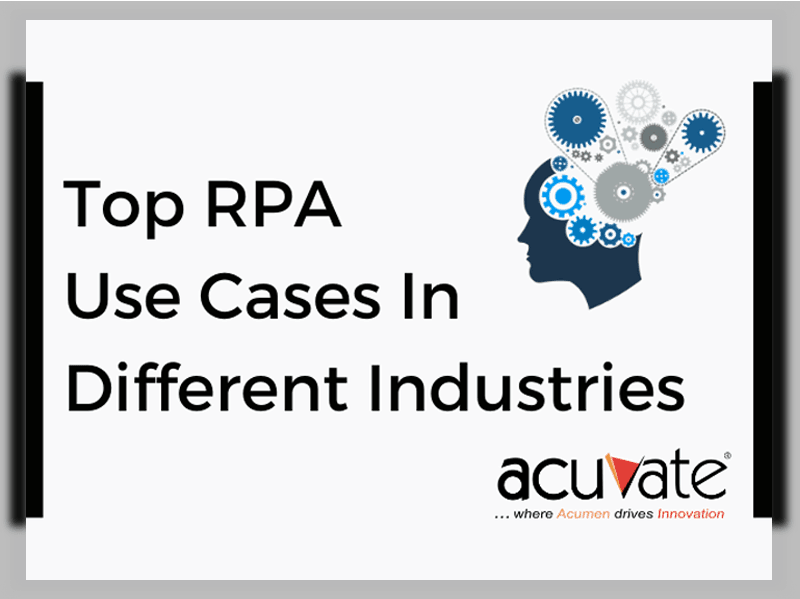Robotic process automation (RPA), despite its capability to automate a wide range of processes and bring about significant improvements in them, is currently more suitable for automating some business operations and not all.
One of the primary steps while implementing Robotic Process Automation (RPA) in an organisation is to select the right business processes to automate that align with the RPA capabilities in the proof of concept (POC) phase. The intended outcome of choosing the right processes for the POC and pilot program is to look for characteristics in the process(es) that will succeed when automated.
Some of the common and fundamental characteristics of automated processes are:
- High in volume and repetitive
- Have predictable rules in their functioning
- Mature and stable with predictable operational costs
- Consistent set of activities and procedures
- Do not undergo fundamental changes to interface or configuration in the short term
- Processes that are triggered by standard and readable electronic inputs like MS Word, Excel, XML, PPT, PDFs.
The following section talks about some of the common business processes that are best suited for RPA.
The Popular Processes To Automate With RPA
1. Sales Orders
While sales representatives are desired to dedicate a large share of their time on interacting with customers, they end up spending their critical time entering data to CRM and ERP systems. Manual handling of data often results in duplication, errors and affects productivity.
RPA can take over end-to-end sales activities by automating tasks such as data replication, invoice preparation and delivery, and consistent updates of customer relationship management. RPA can also maintain a coherent database by cleaning data, and increase sales employees’ satisfaction and productivity by eliminating repetitive low-value tasks.
2. Payroll
Processing payroll is largely manually driven and requires a large volume of data to be handled. Frequent upgradation of standards due to changing statutory and compliance requirements, data inaccuracy issues that lead to delays in payment and employee dissatisfaction are some of the major challenges faced in payroll.
RPA can address these challenges by executing end-to-end payroll related transactions to avoid inaccuracies and delays. RPA can verify employee data consistency across multiple systems, validate time records, update earnings and deductions, maintain records for new hires and terminations, automate paycheck creations and administer benefits, and reimbursements.
3. Employee On-boarding
On-boarding new employees is a cumbersome process for HR and IT departments, as it includes several tasks such as creation of new user accounts, setting up payroll, bank account creation, benefits data processing, email IDs and profiles, access rights, IT equipment requests, and scheduling training and induction. All these tasks have to be repeated over and over again for every new employee.
RPA can be leveraged to automatically execute an on-boarding workflow after creating a new user account. RPA bots can also be configured to send common notifications, documents and information through email to new employees.
4. Accounting Data Entry
A large portion of time in back office operations is consumed in entering data into enterprise resource planning (ERP) system which is manual and prone to errors. Analysts need to collate data from multiple sources in order to update the ERP database and errors in data entry leads to several issues which get compounded down the value stream. With Robotic Process Automation, organizations can automate workflows of ERP data entry, which include data gathering, logging, updating, processing and validating data.
With respect to CRMs, RPA can deliver automatic updates by gathering information on prospective leads and entering the data into the system. Due to the reduced manual data entry, RPA also minimizes errors and maintains clean and organized data for better business intelligence analysis.
5. Accounts Payables Processing
Invoice processing is a challenging task in finance as companies receive invoices in disparate formats like paper copy, mail, fax, PDF, Word Document etc., forcing employees to manually maintain invoice data in the company’s database, in turn making it time-intensive and error prone. RPA can be set up to automatically process invoices upon receipt, irrespective of the channel or format it is received. The RPA bots can automate data input, error reconciliation, keep record of receipts, calculate taxes and pay invoices on time with minimal input from human workers.
Accounts payable is another challenging process in finance due to the presence of outdated systems. RPA provides the following solutions for accounts payable process:
- Automate delivery of documents and data for review, approval, and coding
- Integrate with existing accounting and enterprise systems
- Automate approvals for access and audit trails
6. Claims Processing
Traditional claims processing involves intensive manual labour resulting in inconsistencies and errors. Various channels that capture customer data are not integrated resulting in a lack of fidelity and accountability in the process. Insurance companies are known to rely on legacy apps that drive their core processes which do not integrate well with newer, up-to-date solutions.
Robotic Process Automation (RPA) provides a fully integrated, end-to-end automation solution to overcome the aforementioned challenges. RPA integrates with all applications and systems, including legacy systems, without disrupting the existing technological environment and has a high accuracy.
Conclusion
Although all automated processes have fundamental characteristics in common, RPA’s application differs based on the processes involved across various industries. Organizations need to evaluate the complexity, volume, extent of employee involvement and stability of the processes in order to choose appropriate processes to automate and achieve operational improvements and automation success with RPA. By identifying relevant use cases and incorporating a wide range of RPA performance metrics, organisations can measure progress and draw correlations between different automation benefits.
RPA can be leveraged to deliver high business value, drive significant cost benefits, and align with business goals to have a maximum impact on operational activities. Identifying and implementing the right automation solution will create opportunities to drive immediate results, increase long-term revenue potential and also improve business by creating a continuous and focused improvement in processes. Automated processes eliminate human errors and allow employees to focus on higher-value work, like business improvement, innovation and gaining insights from data to drive greater value for clients.
If you’re planning to implement RPA in your organization, please feel free to get in touch with one of our RPA experts for a personalized consultation. You may also be interested in checking out our RPA implementation services and solutions.



